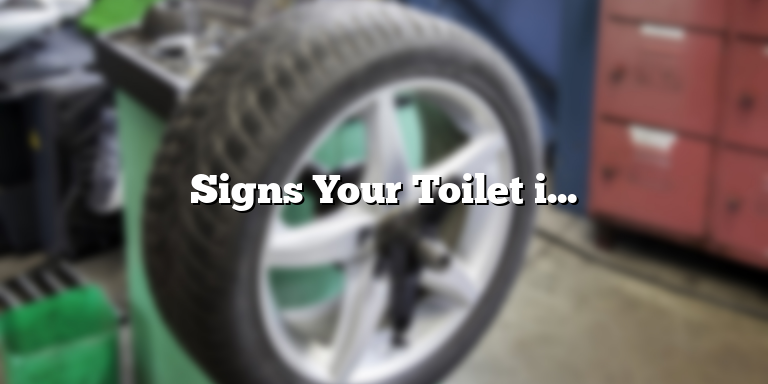
How To Tell If Toilet Is Leaking Underneath
One of the most common and frustrating plumbing issues in a household is a leaking toilet. The problem can be caused by a number of reasons, such as worn out wax ring, a cracked toilet bowl or a damaged flange. Whatever the cause, the leak can be very elusive and difficult to detect, especially if it is happening underneath the toilet. However, there are easy steps you can follow to determine if your toilet is leaking underneath.
Check if Water is Pooling Around the Base of Toilet
This is the easiest and most common way to identify a leaking toilet. If you notice water pooling around the base of your toilet, then there is most likely a leak. The water is usually clear, but it can also be dirty or smelly if it has been sitting there for a while. Before you panic and call a plumber, you can take a few steps to confirm whether there is a leak or not.
Inspect the Wax Ring
The wax ring is a critical component that seals the base of the toilet to the flange and the sewer pipe. Over time, the wax ring can wear out or become damaged, causing water to leak from the base of the toilet. Inspect the wax ring by looking for any signs of wear, cracks or gaps. If you notice any of these issues, it is time to replace the wax ring. This is a job that you can do yourself with the right tools and knowledge or you can call a plumber for assistance.
Check the Toilet Bolts
The toilet bolts are another essential component that holds the toilet to the flange. If the bolts are loose, corroded, or damaged, they can cause leaks. Inspect the bolts by removing the toilet caps and tightening them with a wrench. If the bolts are corroded or damaged, replace them with new ones. It is also important to check that the toilet aligns properly with the flange when you tighten the bolts. If it doesn’t, you may need to replace the flange too.
Examine the Toilet Bowl
A cracked toilet bowl can also cause leaks. Inspect the bowl for any visible cracks or damage. You can do this by adding some food coloring to the water in the tank. Wait a few minutes and then check the bowl for any signs of discoloration. If you notice any of these issues, then you may need to replace the bowl or the entire toilet.
Conclusion
It can be frustrating to deal with a leaking toilet. However, identifying the source of the leak can save you time and money on unnecessary repairs. By following these steps, you can determine if your toilet is leaking underneath and take the necessary action to fix it. If you are not comfortable with DIY plumbing, don’t hesitate to call a professional plumber.
Inspect the Wax Ring
One of the most common causes of a leaking toilet underneath is a damaged or worn-out wax ring. The wax ring is a circular gasket that fits between the base of your toilet and the flange that connects it to the sewage pipes. It seals the connection and prevents water from leaking out of the base.
To check the wax ring, you will need to turn off the water supply valve to your toilet and drain the tank completely. Remove the toilet from the base and inspect the wax ring. Look for any signs of damage, such as cracks, warping, or discoloration. If you notice any of these issues, it’s time to replace the wax ring.
You can purchase a replacement wax ring at any hardware or home improvement store. Choose a high-quality ring that is the same size as your old ring. Make sure to clean the flange thoroughly and remove any old wax residue before installing the new wax ring. Once the new wax ring is in place, carefully reattach your toilet to the flange and turn the water supply back on.
If the wax ring is not the issue, move on to the next potential problem.
Examine the Flange
One of the most common causes of a leaking toilet underneath is a damaged or shifted flange. The flange is the circular object that connects the toilet to the floor, which is typically made of PVC, cast iron or ABS plastic. It is designed to hold the toilet in place and forms a seal between the toilet and the drain pipe that carries waste out of the home.
To determine if the flange is the source of the leak, carefully inspect it for any signs of damage or corrosion. Look for cracks or breaks in the flange itself, or in the bolts that secure the toilet to the floor. If the flange has shifted even slightly, it can cause the wax seal to break or flatten, which can lead to a leak. Use a flashlight to get a clear view of the flange and surrounding area, and inspect all parts carefully.
If you notice any damage to the flange, it will need to be replaced. This will require removing the toilet, breaking the old flange free, and installing a new one in its place. If the flange has shifted, it may be possible to reposition it into place and resecure the bolts to prevent further leaking. Be sure to use the appropriate hardware and tools when reinstalling the toilet to ensure a proper and secure connection.
Check the Water Supply Line
One of the first things you should check if you suspect your toilet is leaking underneath is the water supply line. This line runs from the wall to the toilet and supplies water to the tank to help with flushing. If this line is damaged or not securely connected, it could be causing a leak underneath the toilet.
To check the water supply line, start by turning off the water supply valve located behind the toilet. After turning off the valve, flush the toilet to ensure there is no more water in the tank. Inspect the water supply line for any signs of damage such as cracks, breaks or kinks. If you see any damage, the line will need to be replaced.
Additionally, make sure the water supply line is securely connected to both the wall and the toilet. There should not be any loose connections or fittings. Tighten any loose connections and ensure they are snug. If the water supply line is not securely connected, it could cause water to leak underneath the toilet.
Call a Professional Plumber If Necessary
If you’ve followed the steps and are still unable to locate the source of the leak, or if the problem requires repairs that are beyond your scope of knowledge or expertise, it may be necessary to call a professional plumber to address the issue. Leaking toilets can lead to further issues and cause damage to your home or property if not fixed promptly, so it’s important to seek assistance from a licensed professional who can diagnose the problem and provide appropriate repairs.
A skilled plumber will have the necessary tools and experience to identify and fix the problem efficiently and effectively. This may involve taking apart and reassembling parts of the toilet, replacing damaged components, or even conducting a sewer pipe inspection to ensure there are no additional leaks or blockages further down the line.
When hiring a plumber, it’s important to choose someone who is licensed and insured to protect yourself against any potential liability or damage. Look for reviews or recommendations from others in your community, and be sure to ask about pricing, warranties, and guarantees before agreeing to any repairs or services.
Ultimately, the goal is to fix the leak as quickly and efficiently as possible to prevent further damage and keep your home or property safe and functioning properly. While you may be able to locate and fix some leaks on your own, it’s always a good idea to call in a professional if you are unsure or if the problem seems more complex.
In conclusion, detecting a leak under your toilet may seem like a daunting task, but with a little patience and perseverance, it’s something that can be done on your own. By following the steps outlined above and keeping an eye out for any signs of water damage or leakage in your bathroom, you can identify and fix the problem before it becomes a larger issue. And if all else fails, don’t hesitate to call in a professional to ensure the problem is addressed correctly and efficiently.






